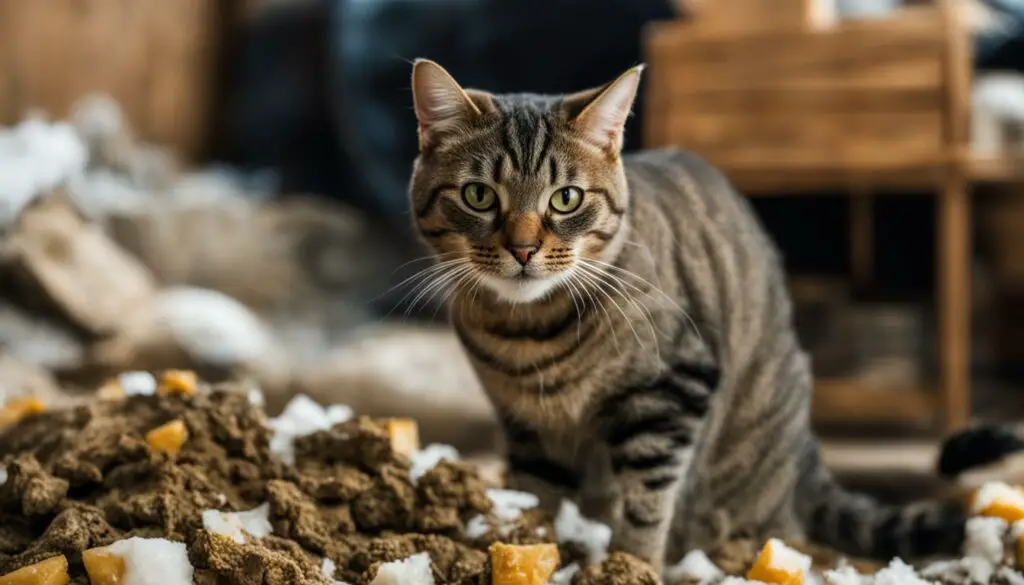Have you ever wondered why your cat makes a strange meowing sound before throwing up? It may seem peculiar, but there is a reason behind this behavior. In this article, I will explain why cats meow before vomiting and discuss the warning signs to look out for. Understanding these behaviors can help you provide the best care for your feline friend.
Key Takeaways:
- Cats may meow before vomiting as a way to express discomfort or nausea.
- Paying attention to this behavior can help identify underlying health issues.
- Common causes of cat vomiting include hairballs, eating too fast, food sensitivities, kidney disease, and intestinal parasites.
- Grooming your cat regularly and providing a stable environment can help prevent vomiting.
- If your cat continues to vomit or shows other concerning symptoms, consult with a veterinarian for proper diagnosis and treatment.
Why Do Cats Meow Before Throwing Up?
Cats meow before throwing up as a way to communicate their discomfort or nausea. It can be a natural response to the physical sensation of vomiting. There are various reasons why cats vomit, including hairballs, eating too fast, food sensitivities, kidney disease, intestinal parasites, or a change in environment. It is important to identify the cause of your cat’s vomiting and address any underlying health issues.
Table: Common Reasons for Cat Vomiting
| Causes | Description |
|---|---|
| Hairballs | Cats ingest loose fur while grooming, resulting in hairballs that need to be expelled. |
| Eating too fast | Consuming food too quickly can lead to an upset stomach and subsequent vomiting. |
| Food sensitivities | Cats with sensitivities or allergies can vomit when exposed to certain foods. |
| Kidney disease | Chronic kidney disease can cause nausea and vomiting in cats. |
| Intestinal parasites | Worms and other parasites can cause vomiting in cats. |
| Change in environment | Cats can become stressed or anxious due to changes in their surroundings, leading to vomiting. |
In some cases, cats may vomit due to a combination of these factors. For example, a cat with hairballs may also have food sensitivities that exacerbate their vomiting episodes. Understanding the root cause of your cat’s vomiting can help you provide appropriate care and prevent further complications.
It’s important to note that occasional vomiting can be normal for cats, especially if it occurs infrequently and is not accompanied by any other worrisome symptoms. However, if your cat’s vomiting is frequent, persistent, or accompanied by other signs of illness such as lethargy, diarrhea, or loss of appetite, it is recommended to consult with a veterinarian for a proper diagnosis and guidance.
Understanding Different Types of Cat Vomiting
Cat vomiting can occur in various forms, each indicating different underlying causes. By understanding the different types of cat vomiting, you can better identify the symptoms, prevent future episodes, and ensure your cat’s overall health and well-being.
Types of Cat Vomiting:
- Throwing up Bile: This type of vomiting is usually yellowish or transparent and occurs when a cat vomits on an empty stomach. It can be a result of illness or a reaction to a foul smell.
- Throwing up Food: Cats may vomit their food due to eating too fast, consuming bad food, or overeating.
- Throwing up Hairballs: Hairballs are a natural result of cats grooming themselves. Excessive hairballs, however, can lead to vomiting and discomfort.
- Throwing up Foreign Objects: Cats have a tendency to play with and ingest foreign objects, which can cause blockages and result in vomiting.
By recognizing the specific type of vomiting your cat exhibits, you can determine the appropriate steps to prevent further episodes and address any underlying issues.
It is important to note that persistent or severe vomiting can indicate a more serious health problem. If your cat’s vomiting is accompanied by other symptoms such as lethargy, loss of appetite, or changes in behavior, it is crucial to consult with a veterinarian for a proper diagnosis and treatment.
Preventing cat vomiting involves maintaining a healthy diet, monitoring your cat’s eating habits, providing regular grooming and hairball prevention measures, and ensuring a stress-free environment. By being attentive to your cat’s needs and promptly addressing any potential issues, you can help keep them happy and healthy.
| Type of Cat Vomiting | Symptoms | Prevention Tips |
|---|---|---|
| Throwing up Bile | Yellowish or transparent vomit, vomiting on an empty stomach | Avoid exposure to foul smells, limit stressful situations |
| Throwing up Food | Vomiting after meals, undigested food in vomit | Feed smaller meals, slow down eating with puzzle feeders |
| Throwing up Hairballs | Coughing, retching, presence of hair in vomit | Regular grooming and brushing, use hairball prevention products |
| Throwing up Foreign Objects | Vomiting after ingesting foreign objects, abdominal discomfort | Keep small objects out of reach, provide appropriate toys and chews |
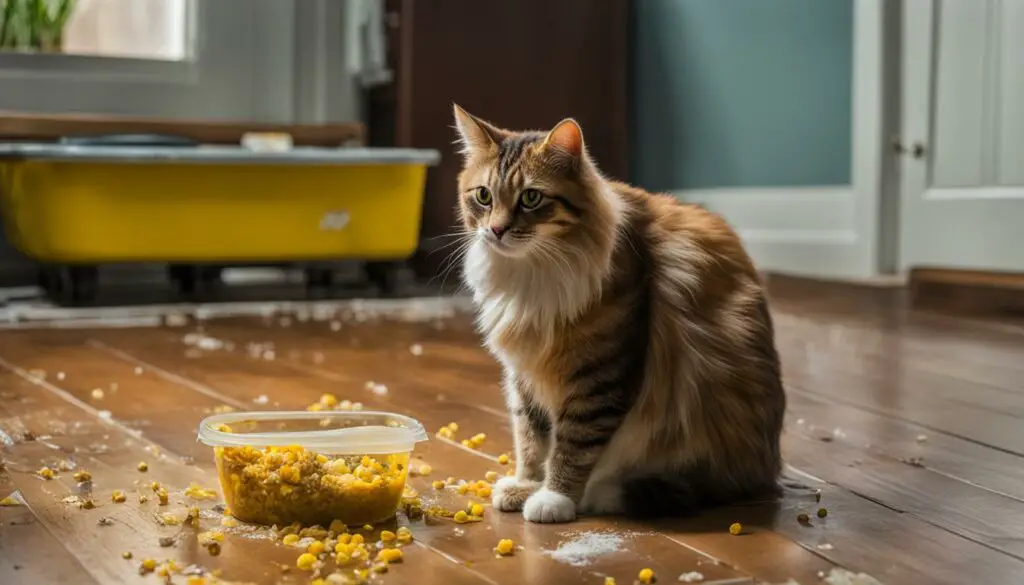
“Proper identification and understanding of the different types of cat vomiting can help owners take appropriate preventive measures for their feline friends.” – Dr. Emily Thompson, Veterinarian
Cat Vomiting and Hairballs
Cat vomiting behavior can often be attributed to hairballs. Cats groom themselves by licking, which results in the ingestion of loose fur. This fur cannot be digested and needs to be expelled from their body. Hairballs are a common occurrence in cats, but excessive hairballs can lead to vomiting.
To prevent hairballs and reduce cat vomiting, regular grooming and brushing are essential. Brushing your cat’s fur helps to remove loose hair before they can ingest it. This can significantly reduce the amount of fur they swallow and subsequently expel through vomiting.
In addition to regular grooming, providing your cat with adequate hydration can also help prevent hairballs. Dehydration can lead to dry skin and increased shedding, which in turn contributes to the formation of hairballs. Make sure your cat has access to fresh water at all times to keep their skin and coat healthy.
| Prevention Tips for Hairballs and Cat Vomiting |
|---|
| 1. Regular grooming and brushing to remove loose fur. |
| 2. Provide your cat with plenty of fresh water to maintain hydration. |
| 3. Introduce hairball remedies or lubricants to aid in the passage of fur. |
| 4. Consider feeding your cat a specialized hairball control diet. |
| 5. Monitor your cat’s behavior and consult with a veterinarian if vomiting persists or worsens. |
By following these preventive measures, you can minimize the occurrence of hairballs and reduce cat vomiting. However, if your cat continues to vomit frequently or exhibits other concerning symptoms, it is important to seek veterinary attention for a proper diagnosis and treatment plan.
Quote:
“Regular grooming and providing your cat with adequate hydration are key to preventing hairballs and reducing cat vomiting.” – Dr. Emily Thompson, Veterinarian.
Eating Too Fast and Cat Vomiting
One common reason why cats meow before throwing up is eating too fast. When a cat consumes their food quickly, it can lead to an upset stomach, causing them to vomit. To prevent this behavior, it is important to monitor your cat’s eating habits and make necessary adjustments.
An effective way to slow down your cat’s eating is by using slow feeders. These specially designed bowls have obstacles or ridges that make it more challenging for cats to gulp down their food. Another method is to divide their meals into smaller portions and feed them multiple times a day. This not only prevents them from overeating but also encourages slower eating.
By implementing these feeding strategies, you can help reduce the likelihood of your cat vomiting after meals. It is important to note that if your cat continues to vomit or shows other symptoms of illness, it is advisable to consult with a veterinarian for a thorough examination and proper diagnosis.
Benefits of using slow feeders for cats:
- Encourages slower eating
- Reduces the risk of vomiting
- Prevents overeating
- Promotes better digestion
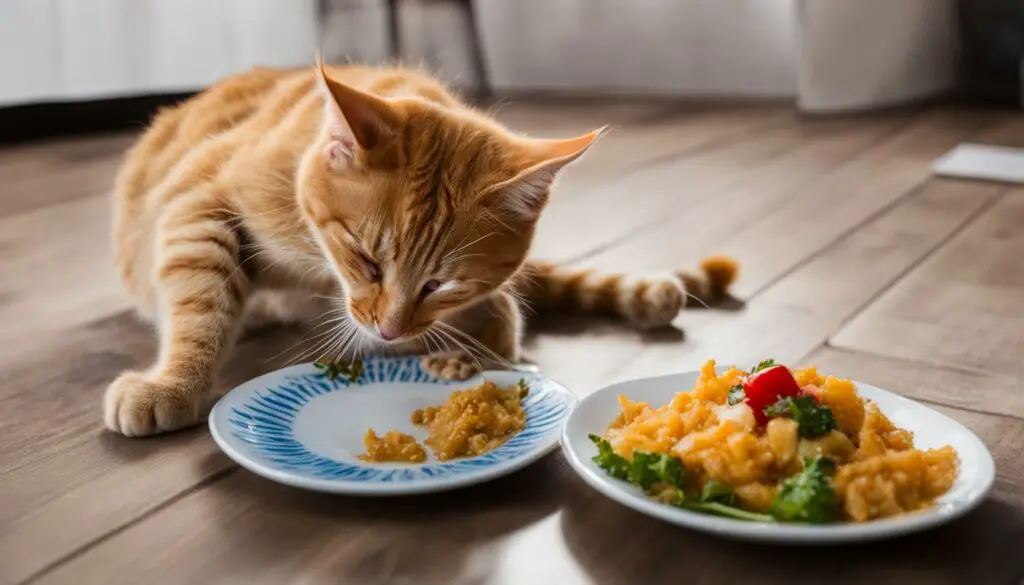
| Eating Too Fast and Cat Vomiting | Preventive Measures |
|---|---|
| Eating too fast can cause upset stomach and vomiting in cats. | Use slow feeders to slow down eating pace. |
| Divide meals into smaller portions and feed multiple times a day. | Monitor your cat’s eating habits and adjust as necessary. |
| If vomiting persists or other symptoms arise, consult with a veterinarian. | Ensure your cat receives a proper diagnosis and treatment. |
Food Sensitivities and Cat Vomiting
Food sensitivities can be a common cause of vomiting in cats. Just like humans, cats can have allergies or sensitivities to certain foods, resulting in digestive issues. It is important to pay attention to any changes in your cat’s eating habits or behavior after introducing a new type of food.
Some common symptoms of food sensitivities in cats include vomiting, diarrhea, excessive gas, or even skin irritations. If your cat displays any of these symptoms after eating, it could be a sign of a food sensitivity. It may be necessary to change their diet and eliminate certain ingredients to determine the culprit.
If you suspect that your cat has food sensitivities, it is recommended to consult with a veterinarian. They can help you create a suitable dietary plan for your cat and provide guidance on how to manage their food sensitivities effectively. Remember to always introduce new foods gradually and monitor your cat’s response to ensure their well-being.
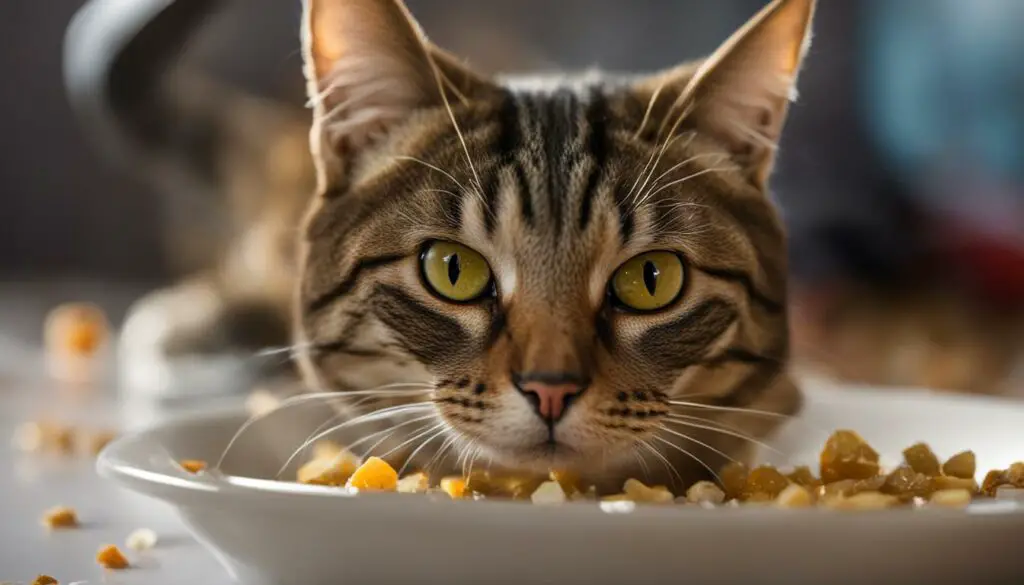
| Common symptoms of food sensitivities in cats: | How to manage food sensitivities: |
|---|---|
|
|
Kidney Disease and Cat Vomiting
When it comes to understanding why cats vomit, kidney disease is a significant factor to consider. As cats age, they become more prone to developing kidney problems, which can lead to nausea and vomiting. The kidneys play a crucial role in filtering waste products from the blood, and when they are not functioning properly, toxins can build up in the cat’s system, causing discomfort and digestive issues.
If your cat is experiencing kidney disease, you may notice additional symptoms such as increased thirst and urination, lack of appetite, and lethargy. It is essential to monitor your cat closely and consult with a veterinarian for a proper diagnosis and treatment plan. The sooner kidney disease is detected, the better chance there is for managing it and minimizing the associated vomiting.
To support your cat’s kidney health, your veterinarian may recommend a specialized diet and medications to manage symptoms and slow down the progression of the disease. It is crucial to follow their guidance and provide your cat with the necessary care to ensure their well-being.
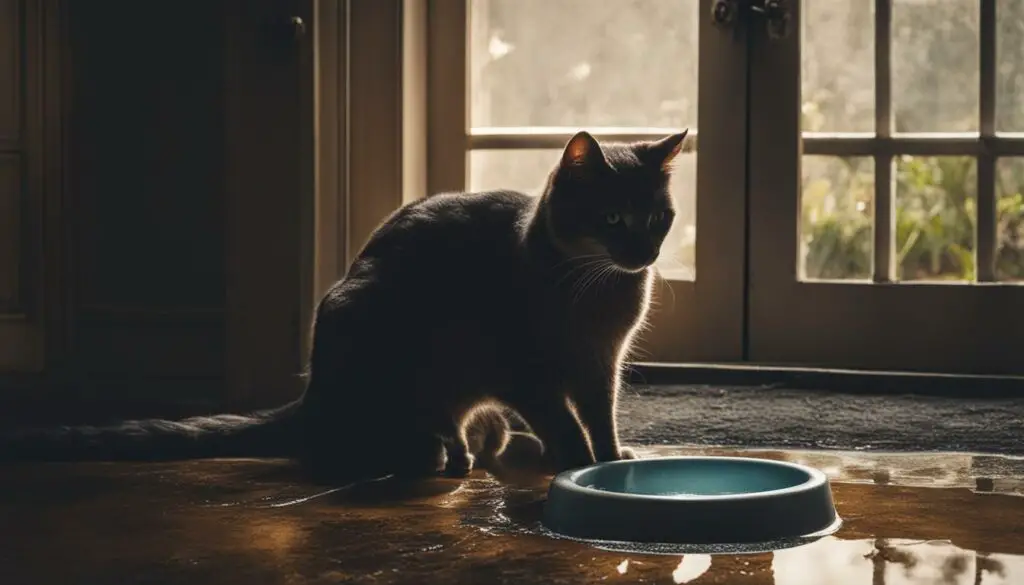
Table: Common Symptoms of Kidney Disease in Cats
| Symptom | Description |
|---|---|
| Increased thirst and urination | Excessive drinking and frequent urination, often seen as larger clumps in the litter box |
| Lack of appetite | Decreased interest in food and weight loss |
| Lethargy | Reduced energy levels and overall sluggishness |
| Vomiting | Frequent or persistent vomiting, often accompanied by other symptoms |
It is important to note that the symptoms listed in the table can also be indicative of other health issues. Therefore, a proper diagnosis from a veterinarian is crucial to determine the underlying cause and provide appropriate treatment.
Intestinal Parasites and Cat Vomiting
Intestinal parasites, such as worms, are a common cause of cat vomiting. These parasites can enter a cat’s system through ingestion or contact with contaminated substances. The presence of intestinal parasites can lead to various symptoms, including nausea, diarrhea, coughing, and mucousy or bloody stool.
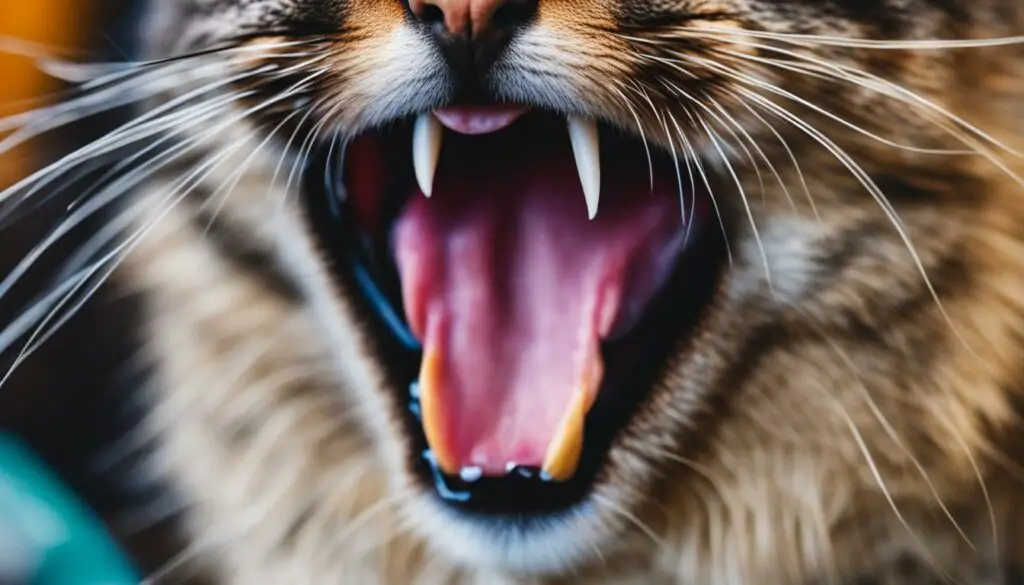
Regular deworming is crucial in managing and preventing intestinal parasites in cats. This involves administering appropriate medications to eliminate the parasites from the cat’s system. It is essential to follow a deworming schedule recommended by a veterinarian to ensure the effectiveness of the treatment.
| Intestinal Parasites | Symptoms |
|---|---|
| Worms (roundworms, tapeworms, hookworms) | Nausea, diarrhea, coughing, mucousy or bloody stool |
| Protozoa (Giardia, Coccidia) | Nausea, diarrhea, abdominal discomfort |
Preventing the spread of intestinal parasites can be achieved through good hygiene practices. Regularly cleaning litter boxes, washing bedding, and keeping living areas clean and sanitized can help reduce the risk of infection. It is also important to avoid allowing cats to roam in areas where they may come into contact with contaminated soil or feces.
If you suspect that your cat has intestinal parasites or if they are exhibiting symptoms of vomiting, it is important to consult with a veterinarian. A veterinarian can perform diagnostic tests to identify the specific parasites and provide appropriate treatment options for your cat’s condition.
A Change in Environment and Cat Vomiting
Cats are sensitive creatures, and any change in their environment can cause stress and anxiety, which may manifest as vomiting. Whether it’s a new addition to the family, a move to a new house, or even rearranging furniture, cats thrive on familiarity and routine. Such changes can disrupt their sense of security and trigger physical symptoms, including vomiting. It’s important to be mindful of these potential triggers and take steps to minimize their impact on your cat’s well-being.
To prevent vomiting caused by a change in environment, create a safe and consistent space for your cat. Provide a designated area where they can retreat to when they feel overwhelmed. Make sure they have access to familiar items, such as their bed, toys, and scratching posts. Additionally, maintaining a regular feeding and playtime schedule can help establish a sense of stability.
Creating a Stress-Free Environment
Reducing stress is crucial in preventing vomiting due to a change in environment. Here are some tips to create a stress-free environment for your cat:
- Introduce changes gradually: If you’re introducing a new pet or moving to a new home, allow your cat time to adjust by gradually introducing them to the new environment or companions.
- Provide hiding spots: Cats feel safer when they have hiding spots where they can retreat and feel secure. Consider providing cozy hiding spots, such as cat trees or covered beds.
- Use pheromone sprays or diffusers: Feline pheromones, such as Feliway, can help create a calming environment and reduce stress-related behaviors.
- Offer plenty of mental and physical stimulation: Engage your cat in play sessions and provide interactive toys to keep them mentally and physically stimulated.
- Minimize disruptions: Keep loud noises, construction, or other disruptive activities to a minimum, as they can add to your cat’s stress levels.
Remember, each cat is unique, and what works for one may not work for another. It’s essential to observe your cat’s behavior closely and make adjustments accordingly. If your cat’s vomiting persists or worsens despite your efforts to create a stress-free environment, it’s advisable to consult with a veterinarian to rule out any underlying health issues.
| Preventing Cat Vomiting Due to a Change in Environment | Summary |
|---|---|
| Create a safe and consistent space for your cat | Establishing familiarity and routine can help reduce stress and minimize vomiting. |
| Introduce changes gradually | Allow your cat time to adjust by gradually introducing them to new companions or environments. |
| Provide hiding spots | Giving your cat designated hiding spots can provide a sense of security. |
| Use pheromone sprays or diffusers | Feline pheromones can help create a calming environment and reduce stress-related behaviors. |
| Offer mental and physical stimulation | Maintaining a stimulating environment can divert your cat’s attention and reduce anxiety. |
| Minimize disruptions | Reducing loud noises or disruptive activities can help create a more peaceful environment. |
By understanding the impact of environmental changes on your cat and taking proactive measures to create a stress-free environment, you can help prevent vomiting and promote your cat’s overall well-being.

Do Cats Throw Up When Upset?
It is not uncommon for cats to vomit when they are upset or stressed. Excessive anxiety or stress can have a direct impact on a cat’s digestion, leading to episodes of vomiting. Just like humans, cats can experience emotional distress, which can manifest in various ways, including gastrointestinal issues. So, if you notice your cat meowing before throwing up, it could be a sign that something is bothering them.
When cats are upset, their body releases stress hormones that can disrupt the normal functioning of their digestive system. This can result in nausea and vomiting. It’s important to note that vomiting is not a conscious act of attention-seeking behavior in cats. Rather, it is a physiological response to their emotional state. So, if your cat is vomiting, it’s essential to try and identify the underlying cause of their distress.
To help alleviate your cat’s upset and reduce the likelihood of vomiting, creating a calm and secure environment is crucial. Provide your cat with a quiet space where they can retreat to when they feel stressed. Additionally, engaging in activities that promote relaxation, such as interactive play and gentle petting, can help reduce their anxiety levels. If your cat continues to vomit or shows signs of severe distress, consulting with a veterinarian is recommended to rule out any underlying health issues.
Remember, cats are sensitive creatures, and their well-being depends on a harmonious environment. By understanding their behavior and providing the necessary care and attention, you can help keep your feline friend healthy and happy.

Do Cats Vomit to Get Attention?
Contrary to popular belief, cats do not vomit to seek attention. Vomiting is a natural response to discomfort, nausea, or underlying health issues. While cats can become anxious or stressed due to changes in their environment or routine, leading to vomiting, it is important to differentiate between genuine sickness and attention-seeking behavior.
If you suspect that your cat’s vomiting is due to stress or anxiety, providing comfort and reassurance can help alleviate their symptoms. Creating a calm and secure environment for your cat, with familiar routines and plenty of affection, can help reduce their stress levels. Additionally, engaging in interactive play and providing enriching toys can help distract your cat from any anxieties they may be experiencing.
However, it is crucial to monitor your cat’s vomiting patterns and behavior. If the vomiting persists or worsens, it is recommended to consult with a veterinarian. A professional can determine if there are any underlying health issues causing the vomiting and provide appropriate treatment.
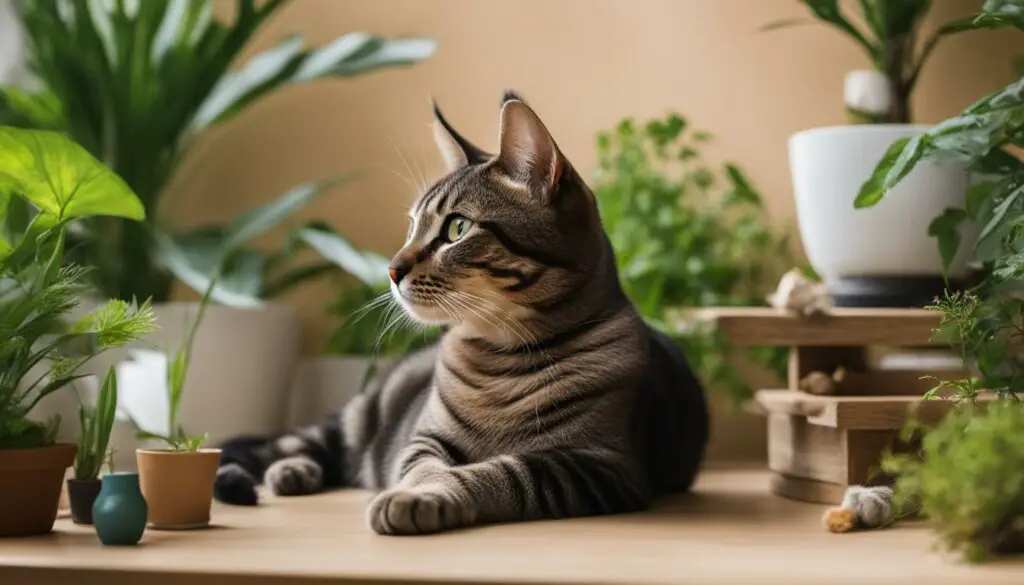
Preventing Cat Vomiting
Preventing cat vomiting involves identifying and addressing the underlying causes. Here are some tips to help minimize your cat’s vomiting episodes:
- Feed your cat smaller meals throughout the day to prevent overeating and reduce the chances of vomiting.
- Use slow feeders or puzzle toys to slow down your cat’s eating, especially if they have a tendency to eat too quickly.
- Provide a balanced and nutritionally complete diet that suits your cat’s specific dietary needs.
- Avoid sudden changes in your cat’s diet, and gradually transition to new foods to minimize the risk of gastrointestinal upset.
- Regularly groom your cat and brush their fur to prevent excessive hairballs.
- Ensure your cat stays hydrated by providing fresh water at all times.
- Keep your cat’s environment stable and stress-free, avoiding unnecessary changes that may trigger anxiety.
By implementing these preventive measures and closely monitoring your cat’s health and behavior, you can help minimize the occurrence of vomiting and ensure your cat’s overall well-being.
Why Do Cats Throw Up Randomly?
Cats are known for their grooming habits, which involve licking their fur to keep it clean and free from mats. However, during this process, they may ingest loose hairs that form hairballs in their stomach. These hairballs can irritate the lining of the stomach, leading to vomiting. While occasional vomiting can be considered normal for cats, throwing up randomly may indicate underlying causes that need attention.
Table: Common Causes of Random Cat Vomiting
| Cause | Signs and Symptoms |
|---|---|
| Dietary issues | Inconsistencies in food, food allergies, or intolerances |
| Ingestion of foreign objects | Vomiting after consuming non-food items |
| Underlying health conditions | Organ diseases, gastrointestinal disorders, or hormonal imbalances |
| Medication or treatment side effects | Reaction to medication or medical procedures |
It is important to note that random vomiting in cats should not be ignored, as it can be a sign of a more serious underlying health condition. If your cat is throwing up frequently without any obvious cause, it is recommended to consult with a veterinarian for proper diagnosis and guidance. The veterinarian will assess your cat’s medical history, conduct a physical examination, and may recommend additional tests such as blood work or imaging to determine the cause and appropriate treatment.
Preventing random cat vomiting involves addressing the underlying causes. Feeding your cat a consistent and balanced diet, avoiding sudden changes in their food, and providing appropriate portions can help reduce digestive upset. Keeping your cat’s environment free from hazardous objects that they may ingest can also minimize the risk of vomiting due to foreign object ingestion. Regular veterinary check-ups and preventive care can help identify and manage any underlying health conditions before they escalate.
Conclusion
Understanding why your cat meows before throwing up is important for their overall health and well-being. It is essential to differentiate between normal behavior and potential health issues to provide appropriate care and prevent further complications.
Monitoring your cat’s diet, environment, and overall behavior can help identify potential triggers for vomiting. Pay attention to any changes in their eating habits, such as eating too fast or exhibiting food sensitivities. Additionally, observe any changes in their surroundings or routines that may be causing stress or anxiety.
If you have any concerns or if your cat’s vomiting persists or worsens, it is recommended to consult with a veterinarian for a proper diagnosis and guidance. A veterinarian will be able to assess your cat’s health, identify any underlying causes of vomiting, and provide the necessary treatment or management plan.
By staying vigilant and proactive in the care of your cat, you can ensure their well-being and take the necessary steps to address any potential health issues that may arise.
FAQ
Why do cats meow before throwing up?
Cats meow before throwing up as a way to communicate their discomfort or nausea.
What are the different types of cat vomiting?
Cat vomiting can occur in different forms, including throwing up bile, food, foreign objects, or hairballs.
How can I prevent my cat from vomiting hairballs?
Regular grooming and brushing, adequate hydration, and hairball remedies can help prevent and manage hairballs in cats.
Why do cats vomit after eating too fast?
Cats can vomit after eating too fast due to an upset stomach. Using slow feeders or dividing meals into smaller portions can help prevent this behavior.
What should I do if my cat has food sensitivities and vomits?
Gradually transitioning to different foods and monitoring their response can help identify any food sensitivities. Consult with a veterinarian for proper guidance.
Can kidney disease cause vomiting in cats?
Yes, kidney disease can cause nausea and vomiting in cats. Monitor your cat for symptoms and consult with a veterinarian for proper diagnosis and treatment.
How can I prevent my cat from getting intestinal parasites and vomiting?
Regular deworming and maintaining good hygiene practices can help prevent and manage intestinal parasites in cats.
Can a change in environment cause vomiting in cats?
Yes, cats can become stressed or anxious due to changes in their environment, which may lead to vomiting. Providing a stable and familiar environment can help prevent this behavior.
Do cats vomit when they are upset?
Cats can vomit when they are upset or stressed. Creating a calm and secure environment can help reduce their stress levels and prevent vomiting.
Do cats vomit to get attention?
Cats do not vomit to get attention. However, they can become anxious or stressed due to changes in their environment or routine, which may lead to vomiting.
Why do cats throw up randomly?
Cats do not throw up randomly. There is always a reason behind each vomiting episode, even if it may not be immediately apparent.

